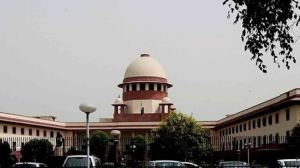Eyes Wide Shut — CR treads the moral high ground
MUMBAI, OCT 15: The demolition of shanties on the railway tracks between Mahim and Vadala on October 4 is a case study of the blinkered a...

MUMBAI, OCT 15: The demolition of shanties on the railway tracks between Mahim and Vadala on October 4 is a case study of the blinkered approach to encroachments. Someone, somewhere in the labyriths of the Central Railway officialdom (there’s an inquiry on to apportion blame) ordered the demolition without informing the local police, or the minister Ram Naik. When the disruptions errupted, an irate state government swiftly reacted. With counting of votes scheduled to start two days later, it was, in bureaucrat-speak, a sensitive’ time. Heart-beats away from victory, Ram Naik too came down heavily on his officers.
In one ham-handed move, the railways had offended the politician and the state government, their two main allies in tackling encroachments. While, the hutments demolished sprang back on the tracks within 48 hours.
In the last one year, the railways have demolished 12,000 illegal shanties on their property. By their own admission, 95 per cent of them have surfaced again. Perumal, who has been living on the tracks at GTB Nagar for 22 years, now says his house is demolished at least four times a year. Konamma, a rag-picker, says it takes three days to reconstruct the shanties. “We just sleep here and start work as soon as the officers depart. Now we have become quite adept,” she says. This is often done with the connivance of local leaders and corporators.
“Demolitions do not work,” says Sheela Patel, director of the Society for Promotion of Area Resources (SPARC), an NGO which has been working in association with the National Slumdwellers Federation for the rehabilitation of squatters on railway land. “But typically, the Central Railway authorities refuse to accept that.” Under instructions from the Railway Board in Delhi they follow a set logic: The slumdwellers are encroachers on their property and hence the railway will not fork out any money for their rehabilitation. They have fielded the same argument in the Bombay High Court, which is hearing a public interest petition filed by the Citizens for Just Society backed by Gandhian Usha Mehta.
“That’s like cutting the nose to spite the face,” exclaims Patel.
The ironies pile up: As per a central government policy guideline, no basic amenities of water, power and sanitation will be provided to encoachers within 30 feet of the railway tracks. Effectively, it means the slumdwellers relieve themselves on the tracks, throw their garbage on the tracks which the BMC staff doesn’t pick up as it is not under their purview and the tracks just clog up. At the receiving end of this chain are motormen like Bendale who are forced to drive at 14 kmph instead of the prescribed 80 kmph.
It is another matter that by the order of the same Government of India, the Ministry for Urban Development gives monetary assistance to various state governments under a scheme to improve the environment of urban slums. So each year, money is allocated for basic amenities but is never utilised by the railways for slums on its land.
The obstructionist approach continues over the issue of rehabiliation. Under the Government of Maharashtra’s Slum Rehabilitation Scheme, the state can help provide tenements or land for the slumdwellers. When Navi Mumbai was to be linked by rail, a stretch of slums at Mankhurd had to be uprooted. After protracted negotiations, says, Sheela Patel, the state government agreed to provide land for re-settlement and the railways agreed to provide Rs 10,000 per family as shifting charges to the state government while SPARC worked with the National Slumdwellers Federation to help construct their houses. The result of this joint effort was the Jan Kalyan Cooperative Housing Society at Kanjur Marg. The sqatters here are no longer encroachers. Yet, says Patel, Kanjur Marg remains an exception to the CR policy. “They have yet to accept the reality of slumdwellers. These people will not be wished away,” says Patel. “Once they do that, they will have to start looking for solutions.”
The state government on its part says that since the slums are on railway land and therefore on central government property they need their cooperation in tackling encroachments and the issue of rehabilitation. As for the railways, they cite the prohibitive cost of rehabilitation and prerogative of their land. From this moral high ground they survey the degeneration of the Harbour Line.



- 01
- 02
- 03
- 04
- 05




























